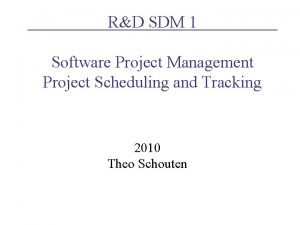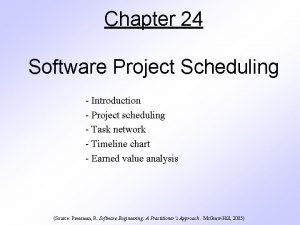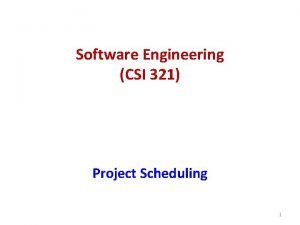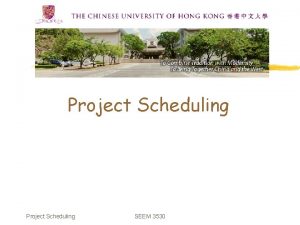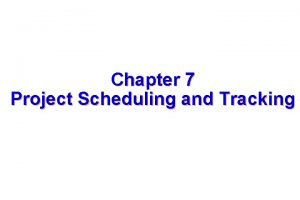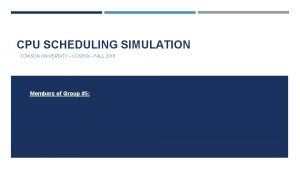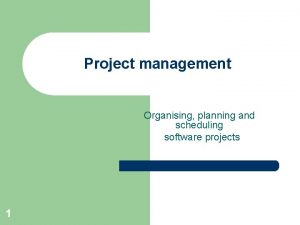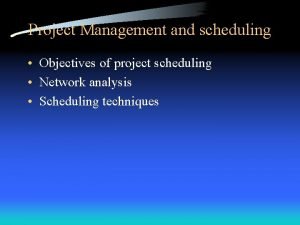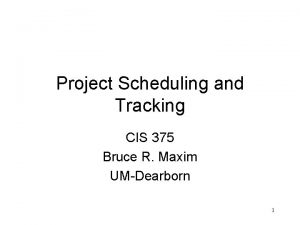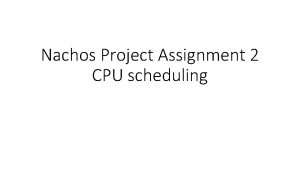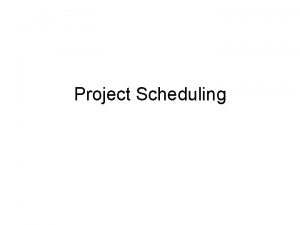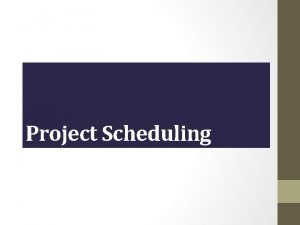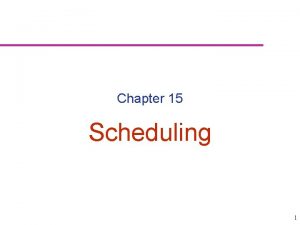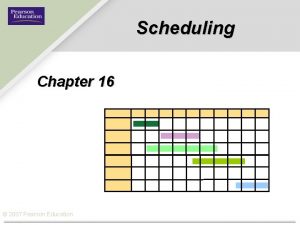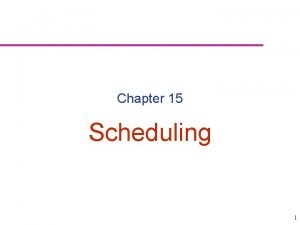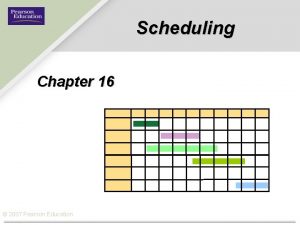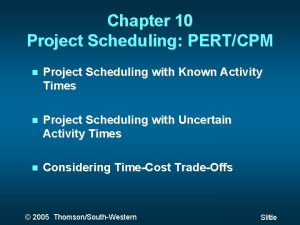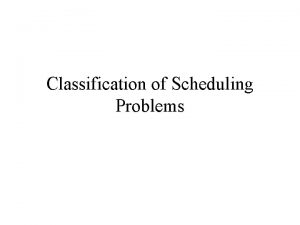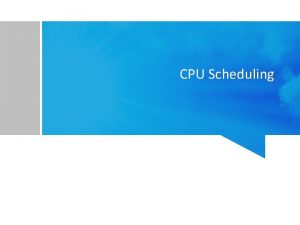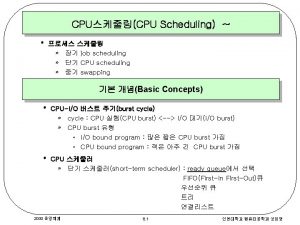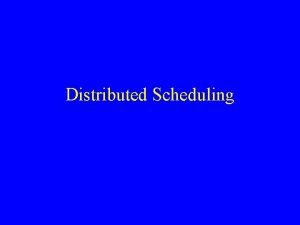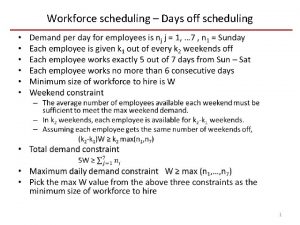Lecture 18 Chapter 27 n Project Scheduling Slide

















- Slides: 17

Lecture 18: Chapter 27 n Project Scheduling Slide Set to accompany Software Engineering: A Practitioner’s Approach, 7/e by Roger S. Pressman Slides copyright © 1996, 2001, 2005, 2009 by Roger S. Pressman For non-profit educational use only May be reproduced ONLY for student use at the university level when used in conjunction with Software Engineering: A Practitioner's Approach, 7/e. Any other reproduction or use is prohibited without the express written permission of the author. All copyright information MUST appear if these slides are posted on a website for student use. 1

Why Are Projects Late? n n n n an unrealistic deadline established by someone outside the software development group changing customer requirements that are not reflected in schedule changes; an honest underestimate of the amount of effort and/or the number of resources that will be required to do the job; predictable and/or unpredictable risks that were not considered when the project commenced; technical difficulties that could not have been foreseen in advance; human difficulties that could not have been foreseen in advance; miscommunication among project staff that results in delays; a failure by project management to recognize that the project is falling behind schedule and a lack of action to correct the problem 2

Scheduling Principles n n n compartmentalization—define distinct tasks interdependency—indicate task interrelationship effort validation—be sure resources are available defined responsibilities—people must be assigned defined outcomes—each task must have an output defined milestones—review for quality 3

Effort and Delivery Time 4

Effort Allocation n n 40 -50% n n customer communication analysis design review and modification construction activities n 15 -20% 30 -40% “front end” activities coding or code generation testing and installation n unit, integration white-box, black box regression 5

Defining Task Sets n n determine type of project assess the degree of rigor required identify adaptation criteria select appropriate software engineering tasks 6

Task Set Refinement 1. 1 Concept scoping determines the overall scope of the project. Task definition: Task 1. 1 Concept Scoping 1. 1. 1 Identify need, benefits and potential customers; 1. 1. 2 Define desired output/control and input events that drive the application; Begin Task 1. 1. 2. 1 FTR: Review written description of need FTR indicates that a formal technical review (Chapter 26) is to be conducted. 1. 1. 2. 2 Derive a list of customer visible outputs/inputs 1. 1. 2. 3 FTR: Review outputs/inputs with customer and revise as required; endtask Task 1. 1. 2 1. 1. 3 Define the functionality/behavior for each major function; Begin Task 1. 1. 3. 1 FTR: Review output and input data objects derived in task 1. 1. 2; 1. 1. 3. 2 Derive a model of functions/behaviors; 1. 1. 3. 3 FTR: Review functions/behaviors with customer and revise as required; endtask Task 1. 1. 3 is refined to 1. 1. 4 Isolate those elements of the technology to be implemented in software; 1. 1. 5 Research availability of existing software; 1. 1. 6 Define technical feasibility; 1. 1. 7 Make quick estimate of size; 1. 1. 8 Create a Scope Definition; end. Task definition: Task 1. 1 7

Define a Task Network 8

Timeline Charts Tasks Week 1 Week 2 Week 3 Week 4 Week n Task 1 Task 2 Task 3 Task 4 Task 5 Task 6 Task 7 Task 8 Task 9 Task 10 Task 11 Task 12 9

Use Automated Tools to Derive a Timeline Chart 10

Schedule Tracking n n n conduct periodic project status meetings in which each team member reports progress and problems. evaluate the results of all reviews conducted throughout the software engineering process. determine whether formal project milestones (the diamonds shown in Figure 27. 3) have been accomplished by the scheduled date. compare actual start-date to planned start-date for each project task listed in the resource table (Figure 27. 4). meet informally with practitioners to obtain their subjective assessment of progress to date and problems on the horizon. use earned value analysis (Section 27. 6) to assess progress quantitatively. 11

Progress on an OO Project-I n Technical milestone: OO analysis completed • All classes and the class hierarchy have been defined and reviewed. • Class attributes and operations associated with a class have been defined and reviewed. • Class relationships (Chapter 8) have been established and reviewed. • A behavioral model (Chapter 8) has been created and reviewed. • Reusable classes have been noted. n Technical milestone: OO design completed • • • The set of subsystems (Chapter 9) has been defined and reviewed. Classes are allocated to subsystems and reviewed. Task allocation has been established and reviewed. Responsibilities and collaborations (Chapter 9) have been identified. Attributes and operations have been designed and reviewed. The communication model has been created and reviewed. 12

Progress on an OO Project-II n Technical milestone: OO programming completed • Each new class has been implemented in code from the design model. • Extracted classes (from a reuse library) have been implemented. • Prototype or increment has been built. n Technical milestone: OO testing • The correctness and completeness of OO analysis and design models has been reviewed. • A class-responsibility-collaboration network (Chapter 6) has been developed and reviewed. • Test cases are designed and class-level tests (Chapter 19) have been conducted for each class. • Test cases are designed and cluster testing (Chapter 19) is completed and the classes are integrated. • System level tests have been completed. 13

Earned Value Analysis (EVA) n Earned value n n n is a measure of progress enables us to assess the “percent of completeness” of a project using quantitative analysis rather than rely on a gut feeling “provides accurate and reliable readings of performance from as early as 15 percent into the project. ” [Fle 98] 14

Computing Earned Value-I n The budgeted cost of work scheduled (BCWS) is determined for each work task represented in the schedule. n n n BCWSi is the effort planned for work task i. To determine progress at a given point along the project schedule, the value of BCWS is the sum of the BCWSi values for all work tasks that should have been completed by that point in time on the project schedule. The BCWS values for all work tasks are summed to derive the budget at completion, BAC. Hence, BAC = ∑ (BCWSk) for all tasks k 15

Computing Earned Value-II n Next, the value for budgeted cost of work performed (BCWP) is computed. n n n The value for BCWP is the sum of the BCWS values for all work tasks that have actually been completed by a point in time on the project schedule. “the distinction between the BCWS and the BCWP is that the former represents the budget of the activities that were planned to be completed and the latter represents the budget of the activities that actually were completed. ” [Wil 99] Given values for BCWS, BAC, and BCWP, important progress indicators can be computed: • Schedule performance index, SPI = BCWP/BCWS • Schedule variance, SV = BCWP – BCWS • SPI is an indication of the efficiency with which the project is utilizing scheduled resources. 16

Computing Earned Value-III n Percent scheduled for completion = BCWS/BAC n n Percent complete = BCWP/BAC n n provides an indication of the percentage of work that should have been completed by time t. provides a quantitative indication of the percent of completeness of the project at a given point in time, t. Actual cost of work performed, ACWP, is the sum of the effort actually expended on work tasks that have been completed by a point in time on the project schedule. It is then possible to compute • Cost performance index, CPI = BCWP/ACWP • Cost variance, CV = BCWP – ACWP 17
 Basic dance steps in heel and toe polka
Basic dance steps in heel and toe polka Job scheduling vs process scheduling
Job scheduling vs process scheduling 01:640:244 lecture notes - lecture 15: plat, idah, farad
01:640:244 lecture notes - lecture 15: plat, idah, farad Sdm project management
Sdm project management Basic principles of project scheduling
Basic principles of project scheduling Project scheduling in software engineering
Project scheduling in software engineering Project scheduling
Project scheduling Compartmentalization interdependency effort validation r
Compartmentalization interdependency effort validation r Cpu scheduling project
Cpu scheduling project Scheduling project management
Scheduling project management Objectives of scheduling
Objectives of scheduling Project scheduling and tracking software quality assurance
Project scheduling and tracking software quality assurance Cpu scheduling project
Cpu scheduling project Factor x^2 - 25
Factor x^2 - 25 Project procurement management lecture notes
Project procurement management lecture notes Software project management handwritten notes
Software project management handwritten notes Project quality management lecture notes
Project quality management lecture notes Software cost estimation notes
Software cost estimation notes



